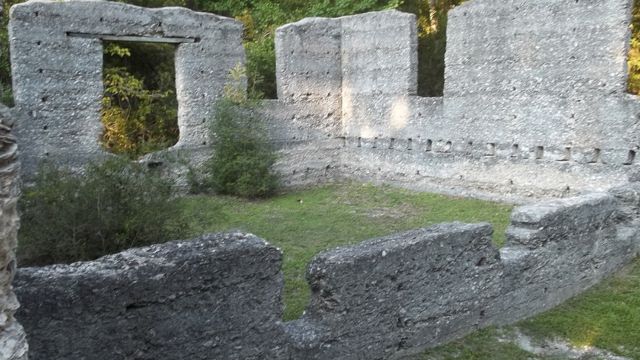Some of the most fascinating abandoned locations may be found in Georgia, a state rich in both natural beauty and historical significance. These locations whisper historical tales, enticing the inquisitive to discover their mysteries. These five enigmatic places serve as silent reminders of the passing of time.
Horton House
Constructed on Jekyll Island in the 1700s, this tabby was originally built for William Horton as a gift from the trustees of the colony of Georgia, recognizing his exceptional military loyalty.
Spanning over 10 acres, the house also housed the island’s first legal brewery. Despite the colony’s disapproval of alcohol during that era, Horton’s brewery thrived as people discovered that his finely crafted beer was a safer alternative to the island’s water.
In 1742, the Horton house fell victim to an attack by Spanish coastal ships, resulting in the destruction of the house, barns, brewery, and other structures. All that remained were the smoking and smoldering tabby walls.
Today, the Horton house is a recognized historic site listed on the National Register of Historic Places. Known for its haunted reputation and ghostly activities, it stands as one of many famous landmarks where visitors check in but might not check out.
Read More: Haunted Routes: Dead Woman’s Crossing and the Ghostly Road of Oklahoma
McIntosh Sugarmill Ruins
The McIntosh Sugarmill Ruins in Georgia stand out among the abandoned places in the state, offering a blend of beauty, intrigue, and unease.
Established in the 1820s through the labor of slaves from two plantations owned by John McIntosh, this site became the first multi-level oxen-powered “sugar works” in Georgia. Here, the entire sugar production process, from cultivation and harvesting to processing and crystallization, occurred under one roof.

Despite the passage of time, the sugar mill endured over two centuries of neglect, retaining its structure while many other buildings from the early 1800s succumbed to decay.
Today, these ruins serve as a captivating physical testament, standing as a reminder of an era long past when similar structures have long since crumbled away into history.
Read More: These Towns in Alabama Have the Best Haunted House Attractions
Georgia Nuclear Aircraft Laboratory
Reimagined like a scene from a vintage 1950s horror film, the Georgia Nuclear Aircraft Laboratory reflects an era when America’s burgeoning fascination with the atomic age collided with the apprehension, fear, and anxiety of the 1960s nuclear cold war threat.
This covert government testing facility was established to investigate the impact of nuclear radiation on military equipment and the natural surroundings. The enigmatic complex is steeped in tales and rumors of the peculiar.
Spanning 10,000 acres, this clandestine nuclear facility was established in the 1950s to explore the consequences of aircraft carrying nuclear payloads on the adjacent vegetation, military gear, and wildlife.
Despite its closure in the 1970s, the majority of the activities conducted within its confines remain shrouded in high levels of classification.
Read More: Ghosts Among Us: Indiana’s Ghost Towns and Their Haunting Histories
Scull Shoals Ghost Town
Scull Sholes Ghost Town bears the heavy legacy of war, slavery, and the sorrowful echoes of eradication and abandonment. For over 10,000 years, the Cherokee and their forebears peacefully inhabited the Scull Scholes forest, engaging in hunting and fishing along the Oconee River.
In the 1700s, the specter of the Revolutionary War cast its shadow upon these indigenous people. Depleting their food sources and decimating the tribe with diseases like smallpox, soldiers of the war also defiled the sacred land.

The newly-formed American government opted to reward the fertile land and its abundant resources to veterans of the American Revolution. Displeased with their ancestral lands being given to newcomers, the Cherokee waged war. Despite being outnumbered and outgunned, they were eventually defeated and displaced.
Ecologists argue that it takes a millennium to form an inch of topsoil in a forest. With the original topsoil being 12 inches thick, it is estimated that approximately 12,000 years will be needed for reforestation to reach the same vitality observed in the 18th century.
Read More: Discover the 5 Most Safest Neighborhoods in Bangor, Maine
Statesboro Packing House
There is ongoing debate about various details surrounding the history of this location. One certainty is that Brooks Simmons inherited the plant in 1917 from his father, who, in turn, had received it from his own father. The operation, now in its third generation, ran successfully for three more years until it was engulfed in flames.
During the Great Depression, Simmons lost everything that remained of his inherited fortune. Overwhelmed by despair, he tragically took his own life.
Beyond the disturbing prospect of thousands of hogs and beef cattle meeting their grizzly, inhumane end at this location, a rumor emerged during that time.
Some claim that Simmons intentionally set the plant on fire, resulting in his own death and the tragic demise of 20 innocent workers who were allegedly trapped inside the blazing concrete structure.
Contemporary explorers insist they have witnessed a distraught woman on the top floor, frantically pounding on a wall in an attempt to escape. Numerous other eerie tales and ghost stories have surfaced, though most researchers have found little substantial evidence to support such claims.
Read More: Discover the 5 Most Haunted Places in Miami, Florida
Final Words
The Horton House shares tales of war from the past, while the eerie remains of the Statesboro Packing House provide a chilling look into the state’s history. These mysterious locations not only offer a glimpse into the rich past of the region but also remind us of the temporary nature of human accomplishments.
Whether they lure us in with historical fascination or are surrounded by unsettling rumors, these deserted places consistently evoke both curiosity and a feeling of wonder.











Leave a Reply